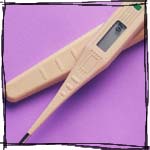15 March 2000 -- Dr Ng Min Ching
General Practitioner
Female and male abnormalities each account for one third of the causes of infertility. In the remaining third, both partners contribute to the problem. In Singapore, around 10-15% of couples are infertile. It must be emphasised that the investigation and treatment of infertility involve both the male and female partners. To understand female infertility, it is essential to have a understanding of the female reproductive tract.
The female reproductive tract
The ovary discharges an egg during a menstrual cycle. The egg travels in the fallopian tube to the womb. Fertilisation of the egg by the sperm occurs in the tube. If fertilisation should take place, the fertilised egg will be embedded in the lining of the womb where foetal development ensues.
Causes of female infertility
- Womb causes
Fibroids, infections or diseases, and congenital malformations of the womb all contribute to the development of female infertility. Repeated abortions with resulting adhesions in and scarring of the womb have similar consequences.
- Cervical and vaginal causes
These include tumours and infections. Very rarely, the female is born with no vagina or a closed vagina.
- Thyroid, adrenal disorders and diabetes
Abnormal production of thyroid or adrenal hormones are associated with infertility. Patients with well-controlled diabetes have normal fertility, but those with poorly controlled diabetes or those with severe complications have impaired fertility.
- Drugs
Certain anti-psychotic drugs are known to cause infertility.
- Excessive weight loss or weight gain
Investigation
A detailed medical and sexual history is taken from the female patient. Questions are asked about previous births, diseases, surgery, menstrual history and sexual history, such as the frequency of intercourse, whether there is pain during intercourse and the sexual positions employed. A physical examination follows, including PAP smears and ultrasounds. For treatment purposes, it is important to assess whether the female is ovulating or not. There are several ways to determine if ovulation has occurred: 
- Charting of body temperature
Every day, on waking and before getting out of bed, the body temperature is measured with a clinical or digital thermometer. The temperature will rise at least 0.2-0.3 degrees Celsius over 1-3 days if ovulation occurs. If pregnancy has happened, the temperature will remain raised. The temperature decreases just before ovulation and rises 24 hours after that. - Measurement of female sex hormones (LH, FSH, oestrogen, progesterone) and prolactin.
Examination of mucus from the cervix.
Once the presence of ovulation is detected, other tests can be performed.
- Post-coital test
The couple undergoes unprotected sexual intercourse 6-12 hours before the investigation. In this test, mucus from the cervix is withdrawn and examined for ovulatary features and the presence of sperm. Absence of sperm points towards poor sexual technique, male infertility, premature ejaculation or douching after sex. - Sperm-cervical mucus test
Cervical mucus from the female and sperm from the male are placed side by side on a glass slide. The test is satisfactory if sperm are seen swimming into the mucus within 15 minutes.
Other investigations are more invasive. They involve surgical or radiological examination of the reproductive system for defects and blockade.
- D&C (dilatation and curettage)
The patient is examined under anaesthesia and a specimen of the womb lining is taken with a curette for microscopic investigation. - Laparoscopy
Under general anaesthesia, a thin tube is inserted into the pelvis for direct visualisation of the ovaries, fallopian tubes, womb and related areas. Blockade of fallopian tubes can be diagnosed at the same time by injecting a methylene blue dye in the cervix. If the tubes are patent, the dye first fills up the womb, flows into the tubes, and then spills out the other end of the tubes. - Hysterosalpingogram
In this procedure, a radio-opaque fluid is injected into the cervix and the passage of the fluid from the cervix to the fallopian tubes is observed with an X-ray image intensifier and video display unit. This is seldom done now as the retention of radio-opaque fluid in the pelvis can cause irritation. - Laparotomy
This is the surgical opening up of the abdominal cavity. It may be used for diagnostic or therapeutic purposes.
Treatment
Treatment is directed at the underlying cause. Diabetes is controlled, thyroid and adrenal disorders are treated, brain tumours are excised, weight loss is achieved, infections are eradicated, offending drugs are stopped and psychological counselling is instituted etc.
Management when ovulation does not occur
Various drugs are currently used to stimulate ovulation.
- Bromocriptine
It is used when the prolactin level in the blood is too high. The treatment is continued for at least 12 months or until pregnancy occurs. - Clomiphene
One course of treatment lasts 5 days. The majority of patients achieve pregnancy within three courses. The success rate are as follows: Ovulation 80%
Pregnancy 40%
Multiple pregnancies 10% The side effects are nausea, vomiting, dryness of vagina, poor cervical mucus and sometimes multiple pregnancies (i.e. having more than one baby at a time).
- Gonadotrophin therapy
Human gonadotrophins are obtained from the brains of cadavers or the urine of postmenopausal women. This therapy can be continued for up to 12 months. The success rates are: Ovulation 90%
Pregnancy 50%
Multiple pregnancies 20% Progesterone
Surgery in female infertility
Fallopian tube blockade is repaired surgically. Endometriosis can be treated either with drugs or via surgery. Fibroids are removed. Abnormalities of the womb or vagina are corrected.
Assisted reproductive techniques
These procedures may have to be resorted to if all else fails. 
- In vitro fertilisation (IVF)
Here, the egg is surgically removed from the female, undergoes fertilisation with the sperm outside the body and then replaced in the womb after three days. - Gamete Intrafallopian transfer (GIFT)
Eggs are removed from the patient and both the eggs and sperms are then placed in the fallopian tube. - Tubal Embryo Transfer (TET)
This is similar to IVF except that the fertilised egg is replaced in the fallopian tube after 24 hours. - Micromanipulation techniques
These are more recent advances. One method is intracytoplasmic sperm injection (ICSI) where the sperm is injected directly into the egg.
Who to consult for infertility
Female patients are referred to gynaecologists/obstetricians by their primary health care physicians (polyclinic doctors or general practitioners).
References:
- T.L.T. Lewis, G.V.P. Chamberlain. Gynaecology by Ten Teachers, 15th edition, 1990. Great Britain.
- Texas Health Resources, www.texashealth.org.arts
Date reviewed: 06 March 2000